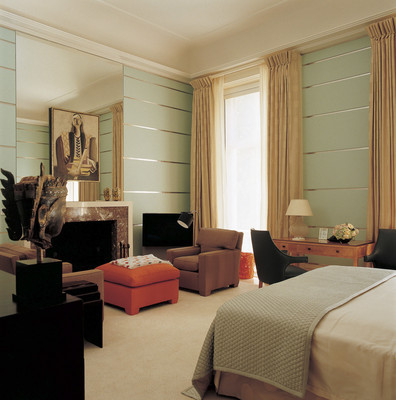Balance style, comfort

Professional as well as amateur designers often find it difficult to make a setting both stylish and comfortable. Achieving one or the other usually isn’t a daunting challenge if “stylish” is taken to mean whatever’s trendy at the moment and if “comfortable” is interpreted as “casual.”
But combining those looks? That can be like furnishing a farmhouse with sleekly minimalist pieces or filling a downtown loft with country-type accoutrements. The solution, of course, is to mix things up. And with today’s easy accessibility to all sorts of styles — whether modern, traditional, Asian or African — it really isn’t so hard to design a room that’s both stylish and comfortable.
Q: The whole time we’ve been redoing our living and dining rooms with contemporary furnishings we have basically ignored the bedroom. It’s actually a bedroom-sitting room combination, which is one reason why we’ve delayed redesigning it. The dual role makes the project complicated.
Our preference is for a conservative yet stylish look — maybe including some antiques with contemporary furniture. Would that be OK? Any general ideas would be appreciated.
A: Yes, it’s quite OK to blend antiques with contemporary furniture, especially if that’s the sort of combination you find appealing. After all, it is a bedroom you’re asking about.
As for general suggestions, may I refer you to a wonderful book, “Mlinaric on Decorating,” that I’ve just been looking through? Among the many inspirational settings it contains, I’ve chosen one that seems to resemble the room you’re describing. David Mlinaric is one of the most notable English interior designers. He has gained an international reputation for decades of distinctive work that doesn’t adhere to any particular style. His interiors are always chic yet never showy; they’re meant to be actually lived in, not merely looked at.
This new book, co-authored with writer Mirabel Cecil and published by Frances Lincoln, features homes Mlinaric has designed for such friends as Lord Rothschild and Mick Jagger.
But name dropping aside, the bedroom-sitting room shown in the photo I chose, has a timeless and elegant look. Its styling could be described as art deco because many of the elements here do make reference to that design movement of the 1920s and ’30s. Deco influences can be seen most clearly in the horizontal striping on the wall, the angularly stepped dropped molding above the uncomplicated window coverings and the mirrored surface above the fireplace mantel.
The furniture has a more contemporary look. But someone versed in French art deco styling will see something familiar in its elegance and simplicity. The color scheme has the same qualities. It’s a combination of beige and light celadon green for the walls and floor, with brown, black and coral red deployed as accents. This setting looks as though it has developed gradually over time. It’s an example of the harmony that seems effortless in the work of a master composer, but can be interpreted and be inspirational for even a more modest setting.
Rita St. Clair is a syndicated columnist with Tribune Media Services Inc. E-mail general interior design questions to her at rsca@ritastclair.com.